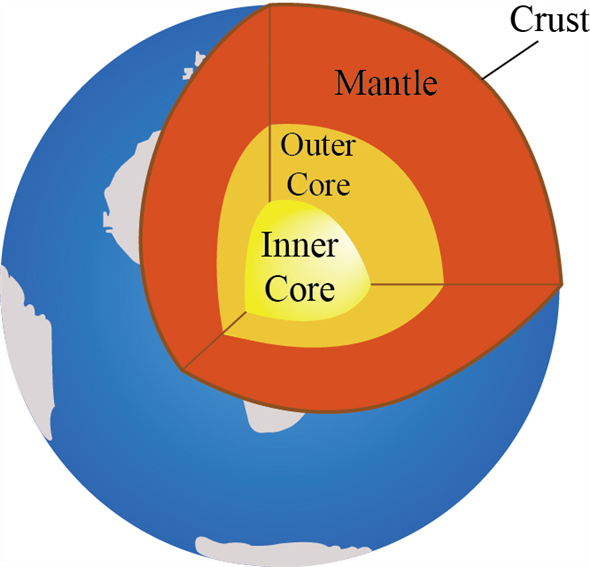Back to: GEOGRAPHY SS1
Welcome to class!
In today’s class, we will be talking about the structure of the earth- the interior zone. Enjoy the class!
The Structure of the Earth
 INTERNAL
INTERNAL
Structure of the earth
The Earth is made up of four distinct layers:

The inner core is in the centre and is the hottest part of the Earth. It is solid and made up of iron and nickel with temperatures of up to 5,500°C. With its immense heat energy, the inner core is like the engine room of the Earth.
The outer core is the layer surrounding the inner core. It is a liquid layer, also made up of iron and nickel. It is still extremely hot, with temperatures similar to the inner core.
The mantle is the widest section of the Earth. It has a thickness of approximately 2,900 km. The mantle is made up of semi-molten rock called magma. In the upper parts of the mantle, the rock is hard, but lower down the rock is soft and beginning to melt.
The crust is the outer layer of the earth. It is a thin layer between 0-60 km thick. The crust is the solid rock layer upon which we live.
There are two different types of crust: continental crust, which carries land, and oceanic crust, which carries water.
Mantle:
Earth’s mantle extends to a depth of 2,890 km, making it the thickest layer of Earth. The mantle is divided into the upper and lower mantle. The upper and lower mantle are separated by the transition zone
Earth crust:
Earth’s crust is made up of several elements: oxygen, 47 percent; silicon, 27 percent; aluminium, 8 percent; iron, 5 percent; calcium, 4 percent; magnesium, potassium and sodium, 2 percent. The crust ranges from 5–70 km (~3–44 miles) in depth and is the outermost layer. The thin parts are the oceanic crust, which underlies the ocean basins (5–10 km) and is composed of dense (mafic) iron magnesium silicate igneous rocks, like basalt.
The thicker crust is the continental crust, which is less dense and composed of (felsic) sodium potassium aluminium silicate rocks, like granite. The rocks of the crust fall into two major categories – sial and sima.
Earth core:
At the centre of the Earth is the core, which has two parts. The solid, inner core of iron has a radius of about 760 miles (about 1,220 km). It is surrounded by a liquid, outer core composed of a nickel-iron alloy. It is about 1,355 miles (2,180 km) thick.
The inner core spins at a different speed than the rest of the planet. This is thought to cause Earth’s magnetic field. When charged particles from the solar wind collide with air molecules above Earth’s magnetic poles, it causes the air molecules to glow, causing the auroras — the northern and southern lights.
Evaluation
- What is the density of sial and sima?
- A major mineral found in the mantle is called _____.
General evaluation
- Iron and Nickel is found in ______.
- State two characteristics of the crust.
- Describe the core of the earth.
- Which minerals make up Sial?
- The core of the earth is made up of ______.
Reading assignment
Essential Geography, O.A. Iwena, Pages 23-24.
Theory
- Draw the inner structure of the earth.
- Write a short note on the crust of the earth.
In our next class, we will be talking about the Rocks of the Earth. We hope you enjoyed the class.
Should you any further question, feel free to ask in the comment section below and trust us to respond as soon as possible.

Very good
This is great